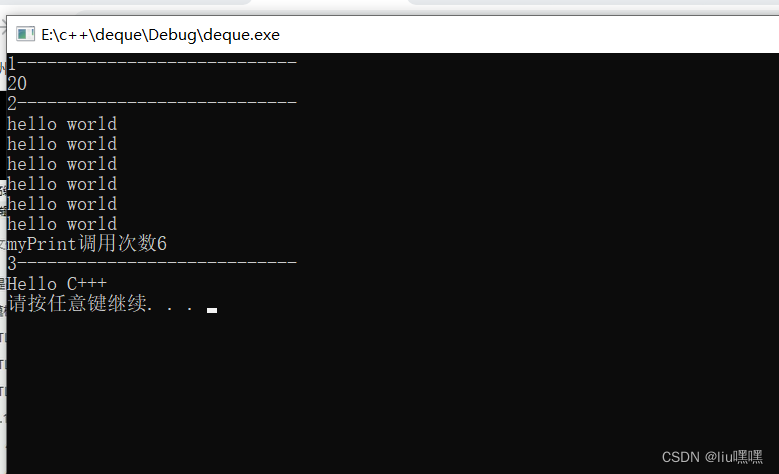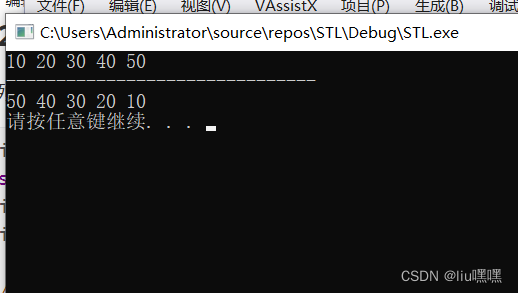4 STL-函数对象
4.1 函数对象
4.1.1 函数对象概念
概念:
-
重载函数调用操作符的类,其对象称为函数对象
-
函数对象使用重载的()时,行为类似函数调用,也叫仿函数
本质:
函数对象(仿函数)是一个类,不是一个函数
4.1.2 函数对象使用
特点:
-
函数对象在使用时,可以像普通函数那样调用,可以有参数,也可以有返回值
-
函数对象超出普通函数的概念,函数对象可以有自己的状态
-
函数对象可以作为参数传递
示例:
#include<iostream>
using namespace std;
#include<string>
?
//函数对象(仿函数)
/***特点:**
?
* 函数对象在使用时,可以像普通函数那样调用,可以有参数,也可以有返回值
* 函数对象超出普通函数的概念,函数对象可以有自己的状态
* 函数对象可以作为参数传递*/
?
class MyAdd
{
public:
int operator()(int v1, int v2)
{
return v1 + v2;
}
};
//1|函数对象在使用时,可以像普通函数那样调用,可以有参数,也可以有返回值
void test01()
{
MyAdd myAdd;
cout << myAdd(10, 10) << endl;
}
?
?
//2、函数对象超出普通函数的概念,函数对象可以有自己的状态
class MyPrint
{
public:
MyPrint()
{
this->count = 0;
}
void operator()(string test)
{
cout << test << endl;
count++;
}
int count;//内部自己状态
};
?
void test02()
{
MyPrint myPrint;
myPrint("hello world");
myPrint("hello world");
myPrint("hello world");
myPrint("hello world");
myPrint("hello world");
myPrint("hello world");
cout << "myPrint调用次数" << myPrint.count << endl;
}
//3、函数对象可以作为参数传递
void doPrint(MyPrint & mp,string ?test)
{
mp(test);
}
?
void test03()
{
MyPrint myPrint;
doPrint(myPrint, "Hello C+++");
}
int main()
{
cout << "1----------------------------" << endl;
test01();
cout << "2----------------------------" << endl;
test02();
cout << "3----------------------------" << endl;
test03();
system("pause");
return ?0;
}
效果图

总结:
-
仿函数写法非常灵活,可以作为参数进行传递
4.2 谓词
4.2.1 谓词概念
概念:
-
返回bool类型的仿函数称为谓词
-
如果operator()接受一个参数,那么叫做一元谓词
-
如果operator()接受两个参数,那么叫做二元谓词
4.2.2 一元谓词
示例:
#include <iostream>
using namespace std;
#include<vector>
#include<algorithm>
?
//仿函数 返回值类型是bool数据类型 ,称为谓词
//一元谓词
class GreaterFive
{
public:
bool operator()(int val)
{
return val > 5;
}
};
?
?
void test01()
{
vector<int> v;
for (int i=0 ;i<10;i++)
{
v.push_back(i);
}
//查找容器中,有哦没有大于5的数字
//GreaterFive()匿名函数对象
vector<int>::iterator it=find_if(v.begin(), v.end(), GreaterFive());
if (it==v.end())
{
cout << "未找到" << endl;
}
else
{
cout << "找到了大于5的数字为:" << *it << endl;
}
?
?
}
?
?
?
int main()
{
test01();
system("pause");
return 0;
}
?
?
效果图:

总结:参数只有一个的谓词,称为一元谓词
4.2.3 二元谓词
示例:
#include <iostream>
using namespace std;
#include<vector>
#include<algorithm>
?
//二元谓词
class MyCompare
{
public:
bool operator()(int &v1, int &v2)
{
return v1 > v2;
}
};
void test01()
{
vector<int> v;
v.push_back(30);
v.push_back(10);
v.push_back(50);
v.push_back(40);
v.push_back(20);
?
//利用系统提供的算法排序
sort(v.begin(), v.end());
?
for (vector<int>::iterator it = v.begin(); it != v.end(); it++)
{
cout << *it << " ";
}
cout << endl;
?
//使用函数对象,改变算法策略,变为排序规则为从大到小
sort(v.begin(), v.end(), MyCompare());
?
cout << "-------------------------------" << endl;
for (vector<int>::iterator it = v.begin(); it != v.end(); it++)
{
cout << *it << " ";
}
cout << endl;
}
?
?
?
int main()
{
test01();
?
system("pause");
return 0;
}
?
?
效果图:

总结:参数只有两个的谓词,称为二元谓词
4.3 内建函数对象
4.3.1 内建函数对象意义
概念:
-
STL内建了一些函数
分类:
-
算数仿函数
-
关系仿函数
-
逻辑仿函数
用法:
-
这些仿函数所产生的对象,用法和一般函数完全相同
-
使用内建函数对象,需要引入头文件#include<functional>
4.3.2 算数仿函数
功能描述:
-
实现四则运算
-
其中negate是一元运算,其他都是二元运算
仿函数原型:
-
template<class T> T plus<T> //加法仿函数
-
template<class T>T minus<T> //减法仿函数
-
template<class T>T multiplies<T>//乘法仿函数
-
template<class T>T divides<T> //除法仿函数
-
template<class T>T modulus<T> //取模仿函数
-
template<class T>T negate<T> //取反仿函数
示例:
#include<iostream>
using namespace std;
#include<functional> //内建函数对象头文件
?
//内建函数对象 算数仿函数
?
//negate 一元仿函数 取反仿函数
?
void test01()
{
negate<int> n;
cout << n(60) << endl;
}
//plus 二元仿函数 加法
void test02()
{
plus<int> p;
cout << p(10, 20) << endl;
}
?
?
?
int main()
{
test01();
test02();
system("pause");
return 0;
}
效果图:

总结:
使用内建函数对象时,需要引用头文件#include<functional>
4.3.3 关系仿函数
功能描述:
-
实现关系对比
仿函数原型:
-
template<class T> bool equal_to <T> //等于
-
template<class T>bool not_equal_to<T> //不等于
-
template<class T>bool greater<T> //大于
-
template<class T>bool greater_equal<T> //大于等于
-
template<class T>bool less<T> //小于
-
template<class T>bool less_equal<T> //小于等于
示例:
#include<iostream>
using namespace std;
#include<functional> //内建函数对象头文件
#include<vector>
#include<algorithm>
?
//内建函数对象 _关系仿函数
//大于 greater
?
class MyCompare
{
public:
bool operator ()(int v1, int v2)
{
return v1 > v2;
}
};
void test01()
{
vector<int> v;
v.push_back(20);
v.push_back(50);
v.push_back(10);
v.push_back(40);
v.push_back(30);
?
for (vector<int> ::iterator it = v.begin();it!=v.end();it++)
{
cout<<*it<<" ";
?
}
cout << endl;
?
//降序
//sort(v.begin(), v.end(),MyCompare());
//greater<int>() 内建函数对象 最常用
sort(v.begin(), v.end(), greater<int>());
for (vector<int> ::iterator it = v.begin(); it != v.end(); it++)
{
cout << *it << " ";
?
}
cout << endl;
?
}
?
?
?
?
int main()
{
test01();
?
system("pause");
return 0;
}
效果图:

4.3.4 逻辑仿函数
功能描述:
-
实现逻辑运算
函数原型:
-
template<class T> bool logical_and<T> //逻辑与
-
template<class T>bool logical_or<T> //逻辑或
-
template<class T> bool logical_not<T> //逻辑非
示例:
#include<iostream>
using namespace std;
#include<vector>
#include<algorithm>
#include<functional>
?
//内建函数对象 _逻辑仿函数
//逻辑非 logical_not
?
void test01()
{
vector<bool> v;
v.push_back(true);
v.push_back(false);
v.push_back(true);
v.push_back(false);
?
for (vector<bool> ::iterator it = v.begin(); it != v.end(); it++)
{
cout << *it << " ";
}
cout << endl;
//利用逻辑非 将容器v 搬运到容器v2中,并执行取反操作
vector<bool> v2;
v2.resize(v.size());//tranform使用前要开辟空间
transform(v.begin(), v.end(), v2.begin(), logical_not<bool>());
for (vector<bool> ::iterator it = v2.begin(); it != v2.end(); it++)
{
cout << *it << " ";
}
cout << endl;
}
?
?
?
?
?
?
?
int main()
{
test01();
system("pause");
return 0;
}
效果图:

总结:逻辑仿函数实际应用较少,了解即可
